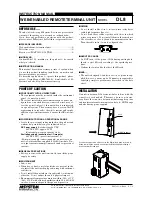
11
9.5. DISPLAY OPTIONS
The display
can work in one of the following two modes: economic (when parameter
17
LCDmod
=
economic
, Table
9.5) or continuous (
LCDmod
=
continuous
). In the economy mode, the display is switched on for several seconds
after each measurement is performed in the recording mode or manually after the “
COPY
” button is pressed. This
mode operation reduces the use of the battery to a minimum, thus extending the time of operation of the
recorder without the need to change the battery.
In the continuous mode, the display is switched on all the time and is updated after one of the following causes
takes place:
−
a measurement and a recording was performed in the recording mode (in accordance with parameter
3:
MPer
, chapter 9.2, Table 9.2)
−
a measurement was performed in accordance with the display update interval (18:
LCDupd
)
−
a measurement was performed after the “
COPY
” button was pressed
The display update period (parameter 18:
LCDupd
) makes it possible to perform measurements also when the
recording is switched off. In order to reduce the use of the battery, it is recommended to set this parameter to a
value greater than 1 min.
Table 9.5. Display options configuration parameters
Parameter
Range of variability of the parameter and description
Default
settings
17:
LCDmod
(1)
display operation mode:
economy
or
continuous
econom.
18:
LCDupd
(1)
interval of display update in the continuous mode:
10 s
-
24 hrs
, 10 s increment
2 minutes
19:
LCDch
value to be displayed
measurement and internal temperature
measurement
and int. temp.
measurement only
9.6. CONFIGURATION OF THE ALARM OUTPUT
When the measured values are displayed, the recorder also enables signaling of alarm conditions with brief flashes
of the “LED-alarm” diode occurring every second. The characteristics and the values of the alarm thresholds for the
measured value are defined by the low alarm (parameter
21:
Alow
) and the high alarm (
20:
AHigh
), see Table 9.6.
In order to obtain the low, high, or outside of band alarm, the low alarm must be set for a value that is
smaller
than the high alarm value - Fig. 9.6.1. An alarm occurs in a preset band when the value of the low alarm is
higher
than the value of the high alarm - Fig. 9.6.2.
Table 9.6. Configuration parameters of
the alarm output
Parameter
Range of variability of the parameter and description
Company
settings
20:
AHigh
high alarm for the
measured value
-199.9
÷
1800
°C or -
1999
÷
18000
units (1)
18000
°C
21:
Alow
low alarm for the
measured value
-199.9
÷
1800
°C or -
1999
÷
18000
units (1)
-199.9
°C
Notes: (1)
– applies to analog inputs ( mA, V, mV, Ω )
































